Correlation of Self-Motivation, Peer Climate, and Well-being Report
VerifiedAdded on 2019/09/19
|5
|1225
|397
Report
AI Summary
This report investigates the relationship between self-motivation, peer climate, and well-being among undergraduate psychology students at Coventry University. The study employed a cross-sectional and correlational design, assessing the influence of intrinsic, extrinsic, and amotivation on student engagement. Data was collected through a multi-section questionnaire, including the Academic Motivation Scale (AMS). Statistical analysis, including multiple linear regression, revealed that intrinsic motivation was the strongest predictor of engagement, while both extrinsic motivation and amotivation also significantly influenced engagement. The report details the methodology, participants, and statistical analyses, including tests for normality, multi-collinearity, and homogeneity of error variance, ensuring the validity of the findings. The results indicate that 72.1% of the variation in engagement is explained by the independent variables. The report concludes by highlighting the importance of self-motivation and well-being in higher education and its impact on student success.
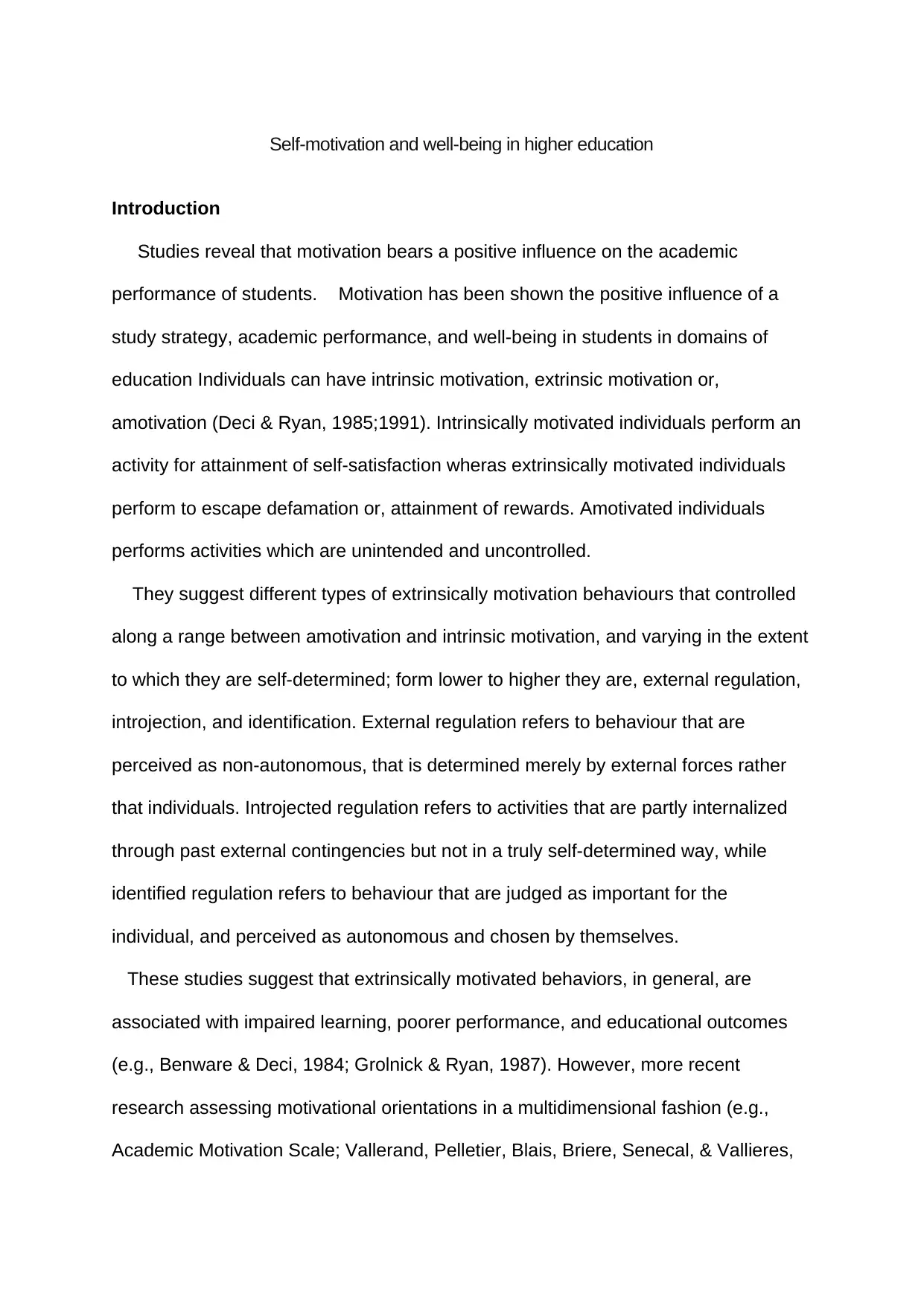
Self-motivation and well-being in higher education
Introduction
Studies reveal that motivation bears a positive influence on the academic
performance of students. Motivation has been shown the positive influence of a
study strategy, academic performance, and well-being in students in domains of
education Individuals can have intrinsic motivation, extrinsic motivation or,
amotivation (Deci & Ryan, 1985;1991). Intrinsically motivated individuals perform an
activity for attainment of self-satisfaction wheras extrinsically motivated individuals
perform to escape defamation or, attainment of rewards. Amotivated individuals
performs activities which are unintended and uncontrolled.
They suggest different types of extrinsically motivation behaviours that controlled
along a range between amotivation and intrinsic motivation, and varying in the extent
to which they are self-determined; form lower to higher they are, external regulation,
introjection, and identification. External regulation refers to behaviour that are
perceived as non-autonomous, that is determined merely by external forces rather
that individuals. Introjected regulation refers to activities that are partly internalized
through past external contingencies but not in a truly self-determined way, while
identified regulation refers to behaviour that are judged as important for the
individual, and perceived as autonomous and chosen by themselves.
These studies suggest that extrinsically motivated behaviors, in general, are
associated with impaired learning, poorer performance, and educational outcomes
(e.g., Benware & Deci, 1984; Grolnick & Ryan, 1987). However, more recent
research assessing motivational orientations in a multidimensional fashion (e.g.,
Academic Motivation Scale; Vallerand, Pelletier, Blais, Briere, Senecal, & Vallieres,
Introduction
Studies reveal that motivation bears a positive influence on the academic
performance of students. Motivation has been shown the positive influence of a
study strategy, academic performance, and well-being in students in domains of
education Individuals can have intrinsic motivation, extrinsic motivation or,
amotivation (Deci & Ryan, 1985;1991). Intrinsically motivated individuals perform an
activity for attainment of self-satisfaction wheras extrinsically motivated individuals
perform to escape defamation or, attainment of rewards. Amotivated individuals
performs activities which are unintended and uncontrolled.
They suggest different types of extrinsically motivation behaviours that controlled
along a range between amotivation and intrinsic motivation, and varying in the extent
to which they are self-determined; form lower to higher they are, external regulation,
introjection, and identification. External regulation refers to behaviour that are
perceived as non-autonomous, that is determined merely by external forces rather
that individuals. Introjected regulation refers to activities that are partly internalized
through past external contingencies but not in a truly self-determined way, while
identified regulation refers to behaviour that are judged as important for the
individual, and perceived as autonomous and chosen by themselves.
These studies suggest that extrinsically motivated behaviors, in general, are
associated with impaired learning, poorer performance, and educational outcomes
(e.g., Benware & Deci, 1984; Grolnick & Ryan, 1987). However, more recent
research assessing motivational orientations in a multidimensional fashion (e.g.,
Academic Motivation Scale; Vallerand, Pelletier, Blais, Briere, Senecal, & Vallieres,
Paraphrase This Document
Need a fresh take? Get an instant paraphrase of this document with our AI Paraphraser
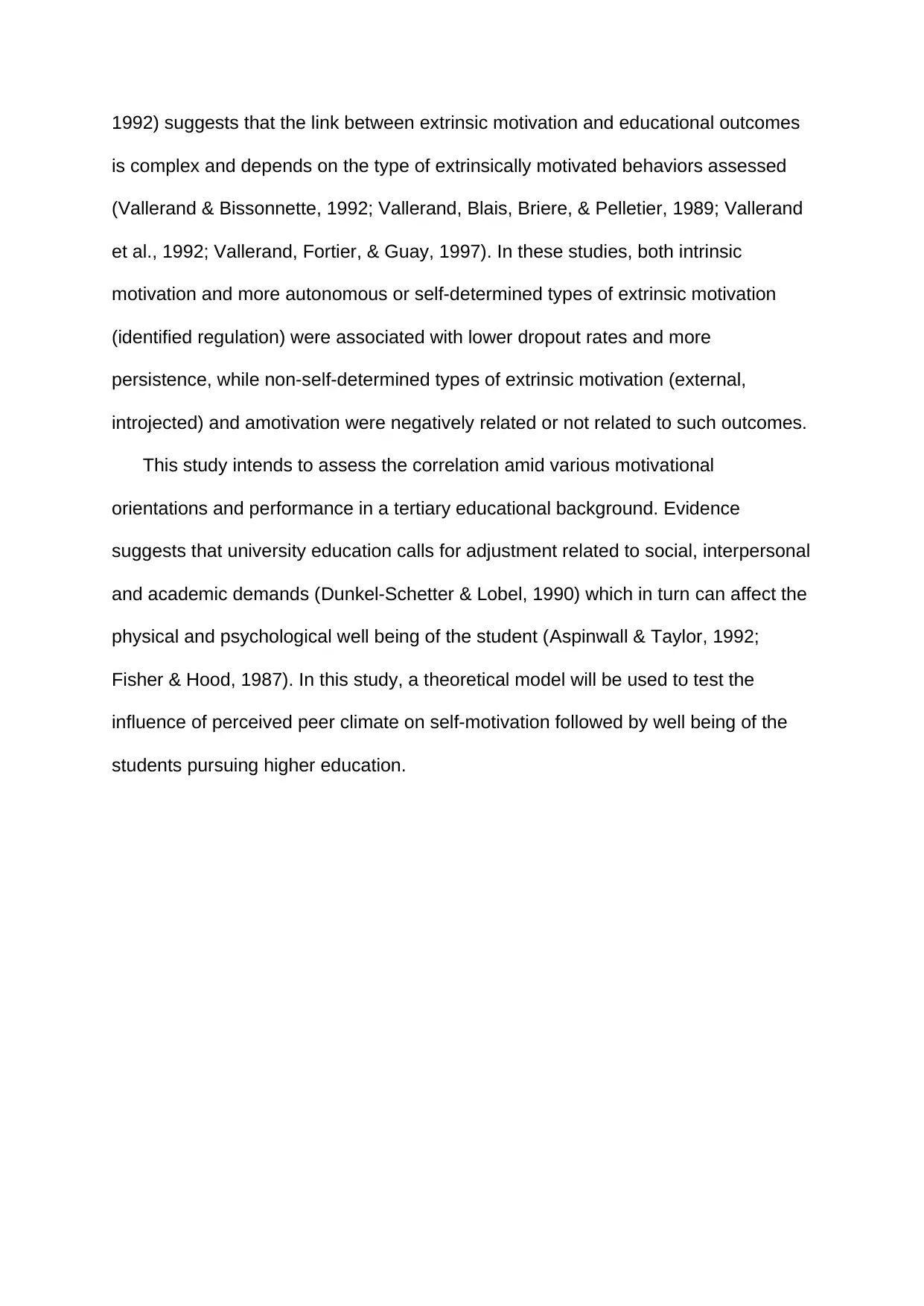
1992) suggests that the link between extrinsic motivation and educational outcomes
is complex and depends on the type of extrinsically motivated behaviors assessed
(Vallerand & Bissonnette, 1992; Vallerand, Blais, Briere, & Pelletier, 1989; Vallerand
et al., 1992; Vallerand, Fortier, & Guay, 1997). In these studies, both intrinsic
motivation and more autonomous or self-determined types of extrinsic motivation
(identified regulation) were associated with lower dropout rates and more
persistence, while non-self-determined types of extrinsic motivation (external,
introjected) and amotivation were negatively related or not related to such outcomes.
This study intends to assess the correlation amid various motivational
orientations and performance in a tertiary educational background. Evidence
suggests that university education calls for adjustment related to social, interpersonal
and academic demands (Dunkel-Schetter & Lobel, 1990) which in turn can affect the
physical and psychological well being of the student (Aspinwall & Taylor, 1992;
Fisher & Hood, 1987). In this study, a theoretical model will be used to test the
influence of perceived peer climate on self-motivation followed by well being of the
students pursuing higher education.
is complex and depends on the type of extrinsically motivated behaviors assessed
(Vallerand & Bissonnette, 1992; Vallerand, Blais, Briere, & Pelletier, 1989; Vallerand
et al., 1992; Vallerand, Fortier, & Guay, 1997). In these studies, both intrinsic
motivation and more autonomous or self-determined types of extrinsic motivation
(identified regulation) were associated with lower dropout rates and more
persistence, while non-self-determined types of extrinsic motivation (external,
introjected) and amotivation were negatively related or not related to such outcomes.
This study intends to assess the correlation amid various motivational
orientations and performance in a tertiary educational background. Evidence
suggests that university education calls for adjustment related to social, interpersonal
and academic demands (Dunkel-Schetter & Lobel, 1990) which in turn can affect the
physical and psychological well being of the student (Aspinwall & Taylor, 1992;
Fisher & Hood, 1987). In this study, a theoretical model will be used to test the
influence of perceived peer climate on self-motivation followed by well being of the
students pursuing higher education.
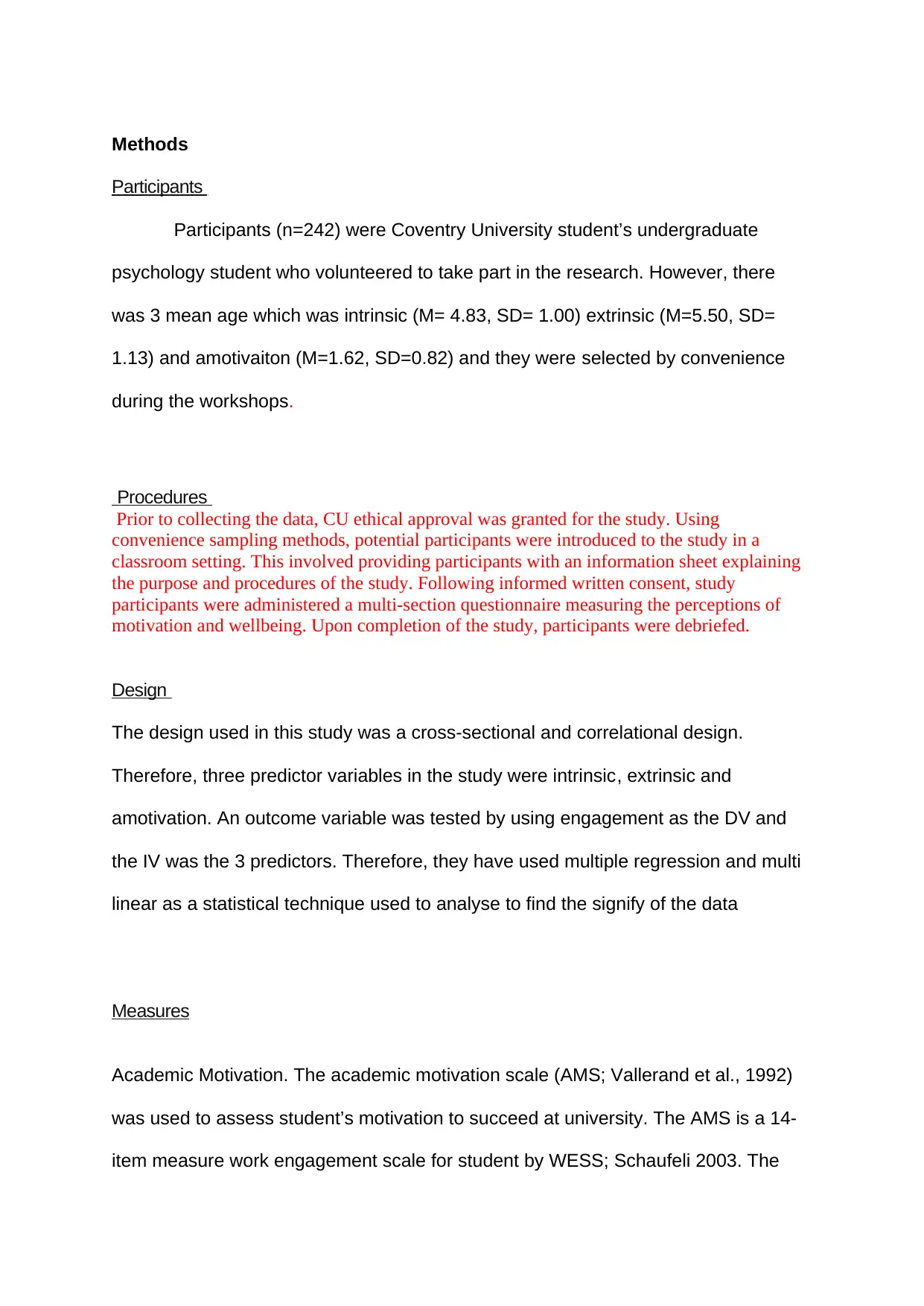
Methods
Participants
Participants (n=242) were Coventry University student’s undergraduate
psychology student who volunteered to take part in the research. However, there
was 3 mean age which was intrinsic (M= 4.83, SD= 1.00) extrinsic (M=5.50, SD=
1.13) and amotivaiton (M=1.62, SD=0.82) and they were selected by convenience
during the workshops.
Procedures
Prior to collecting the data, CU ethical approval was granted for the study. Using
convenience sampling methods, potential participants were introduced to the study in a
classroom setting. This involved providing participants with an information sheet explaining
the purpose and procedures of the study. Following informed written consent, study
participants were administered a multi-section questionnaire measuring the perceptions of
motivation and wellbeing. Upon completion of the study, participants were debriefed.
Design
The design used in this study was a cross-sectional and correlational design.
Therefore, three predictor variables in the study were intrinsic, extrinsic and
amotivation. An outcome variable was tested by using engagement as the DV and
the IV was the 3 predictors. Therefore, they have used multiple regression and multi
linear as a statistical technique used to analyse to find the signify of the data
Measures
Academic Motivation. The academic motivation scale (AMS; Vallerand et al., 1992)
was used to assess student’s motivation to succeed at university. The AMS is a 14-
item measure work engagement scale for student by WESS; Schaufeli 2003. The
Participants
Participants (n=242) were Coventry University student’s undergraduate
psychology student who volunteered to take part in the research. However, there
was 3 mean age which was intrinsic (M= 4.83, SD= 1.00) extrinsic (M=5.50, SD=
1.13) and amotivaiton (M=1.62, SD=0.82) and they were selected by convenience
during the workshops.
Procedures
Prior to collecting the data, CU ethical approval was granted for the study. Using
convenience sampling methods, potential participants were introduced to the study in a
classroom setting. This involved providing participants with an information sheet explaining
the purpose and procedures of the study. Following informed written consent, study
participants were administered a multi-section questionnaire measuring the perceptions of
motivation and wellbeing. Upon completion of the study, participants were debriefed.
Design
The design used in this study was a cross-sectional and correlational design.
Therefore, three predictor variables in the study were intrinsic, extrinsic and
amotivation. An outcome variable was tested by using engagement as the DV and
the IV was the 3 predictors. Therefore, they have used multiple regression and multi
linear as a statistical technique used to analyse to find the signify of the data
Measures
Academic Motivation. The academic motivation scale (AMS; Vallerand et al., 1992)
was used to assess student’s motivation to succeed at university. The AMS is a 14-
item measure work engagement scale for student by WESS; Schaufeli 2003. The
⊘ This is a preview!⊘
Do you want full access?
Subscribe today to unlock all pages.

Trusted by 1+ million students worldwide
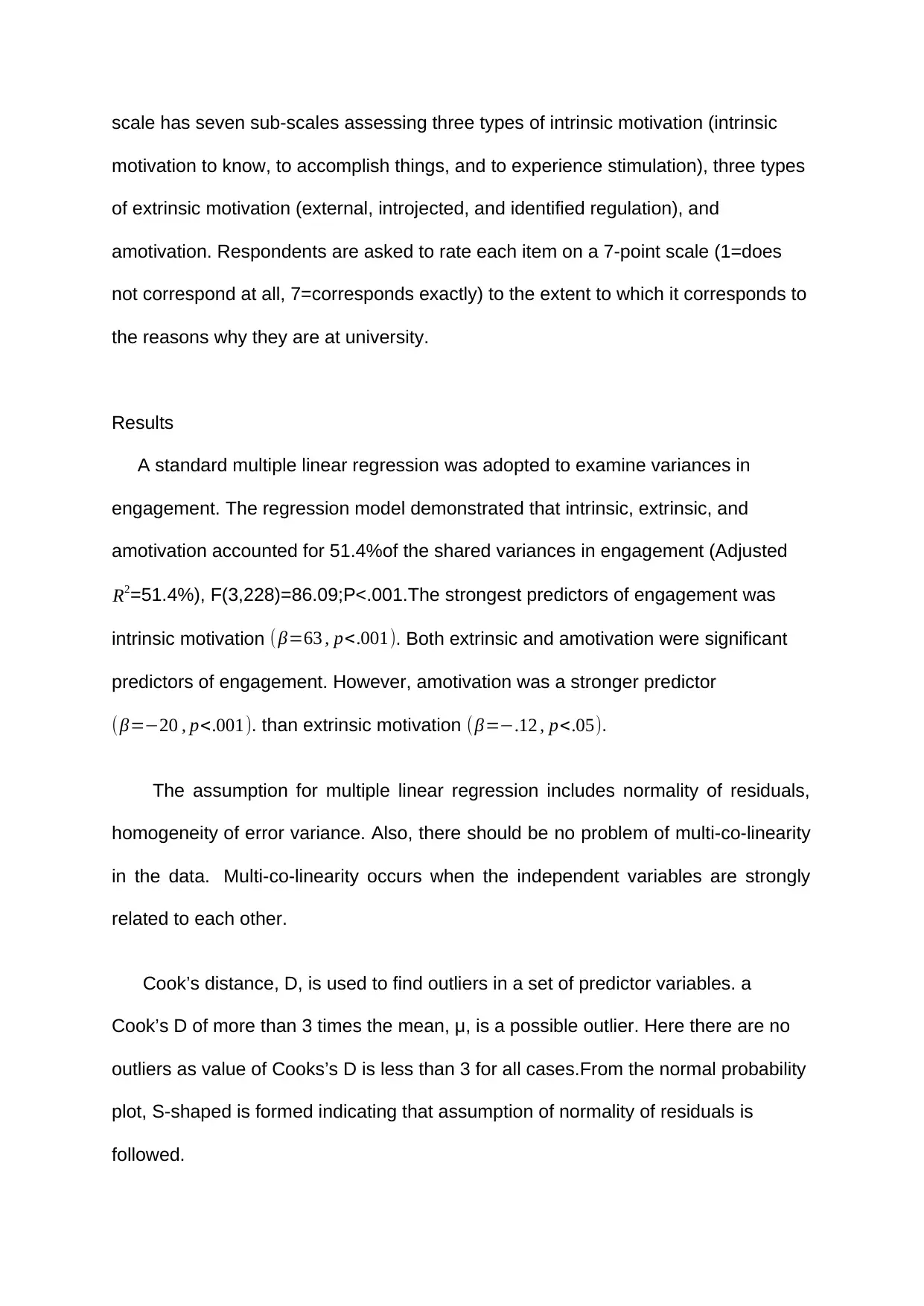
scale has seven sub-scales assessing three types of intrinsic motivation (intrinsic
motivation to know, to accomplish things, and to experience stimulation), three types
of extrinsic motivation (external, introjected, and identified regulation), and
amotivation. Respondents are asked to rate each item on a 7-point scale (1=does
not correspond at all, 7=corresponds exactly) to the extent to which it corresponds to
the reasons why they are at university.
Results
A standard multiple linear regression was adopted to examine variances in
engagement. The regression model demonstrated that intrinsic, extrinsic, and
amotivation accounted for 51.4%of the shared variances in engagement (Adjusted
R2=51.4%), F(3,228)=86.09;P<.001.The strongest predictors of engagement was
intrinsic motivation (β=63 , p<.001). Both extrinsic and amotivation were significant
predictors of engagement. However, amotivation was a stronger predictor
(β=−20 , p<.001). than extrinsic motivation (β=−.12 , p<.05).
The assumption for multiple linear regression includes normality of residuals,
homogeneity of error variance. Also, there should be no problem of multi-co-linearity
in the data. Multi-co-linearity occurs when the independent variables are strongly
related to each other.
Cook’s distance, D, is used to find outliers in a set of predictor variables. a
Cook’s D of more than 3 times the mean, μ, is a possible outlier. Here there are no
outliers as value of Cooks’s D is less than 3 for all cases.From the normal probability
plot, S-shaped is formed indicating that assumption of normality of residuals is
followed.
motivation to know, to accomplish things, and to experience stimulation), three types
of extrinsic motivation (external, introjected, and identified regulation), and
amotivation. Respondents are asked to rate each item on a 7-point scale (1=does
not correspond at all, 7=corresponds exactly) to the extent to which it corresponds to
the reasons why they are at university.
Results
A standard multiple linear regression was adopted to examine variances in
engagement. The regression model demonstrated that intrinsic, extrinsic, and
amotivation accounted for 51.4%of the shared variances in engagement (Adjusted
R2=51.4%), F(3,228)=86.09;P<.001.The strongest predictors of engagement was
intrinsic motivation (β=63 , p<.001). Both extrinsic and amotivation were significant
predictors of engagement. However, amotivation was a stronger predictor
(β=−20 , p<.001). than extrinsic motivation (β=−.12 , p<.05).
The assumption for multiple linear regression includes normality of residuals,
homogeneity of error variance. Also, there should be no problem of multi-co-linearity
in the data. Multi-co-linearity occurs when the independent variables are strongly
related to each other.
Cook’s distance, D, is used to find outliers in a set of predictor variables. a
Cook’s D of more than 3 times the mean, μ, is a possible outlier. Here there are no
outliers as value of Cooks’s D is less than 3 for all cases.From the normal probability
plot, S-shaped is formed indicating that assumption of normality of residuals is
followed.
Paraphrase This Document
Need a fresh take? Get an instant paraphrase of this document with our AI Paraphraser
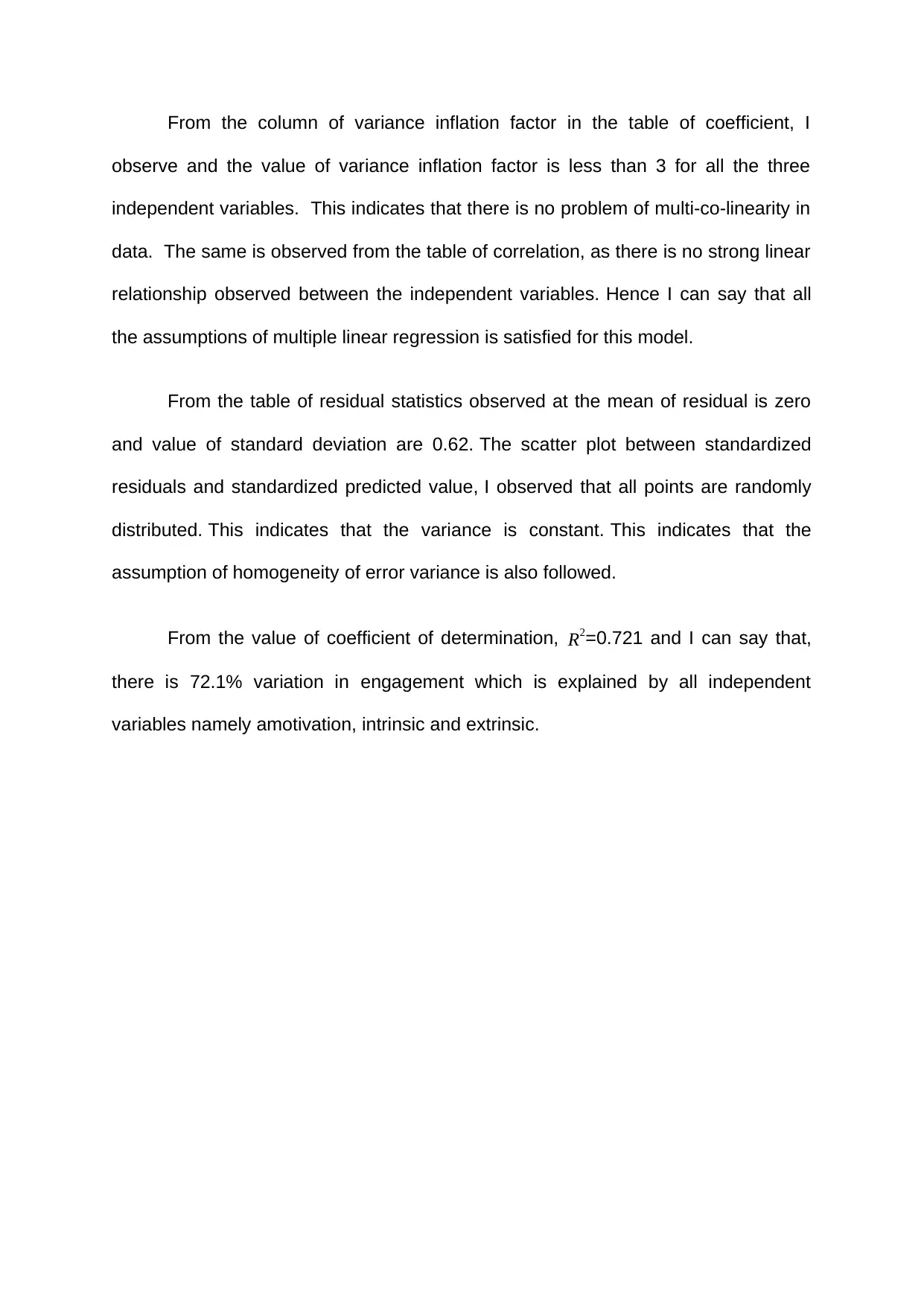
From the column of variance inflation factor in the table of coefficient, I
observe and the value of variance inflation factor is less than 3 for all the three
independent variables. This indicates that there is no problem of multi-co-linearity in
data. The same is observed from the table of correlation, as there is no strong linear
relationship observed between the independent variables. Hence I can say that all
the assumptions of multiple linear regression is satisfied for this model.
From the table of residual statistics observed at the mean of residual is zero
and value of standard deviation are 0.62. The scatter plot between standardized
residuals and standardized predicted value, I observed that all points are randomly
distributed. This indicates that the variance is constant. This indicates that the
assumption of homogeneity of error variance is also followed.
From the value of coefficient of determination, R2=0.721 and I can say that,
there is 72.1% variation in engagement which is explained by all independent
variables namely amotivation, intrinsic and extrinsic.
observe and the value of variance inflation factor is less than 3 for all the three
independent variables. This indicates that there is no problem of multi-co-linearity in
data. The same is observed from the table of correlation, as there is no strong linear
relationship observed between the independent variables. Hence I can say that all
the assumptions of multiple linear regression is satisfied for this model.
From the table of residual statistics observed at the mean of residual is zero
and value of standard deviation are 0.62. The scatter plot between standardized
residuals and standardized predicted value, I observed that all points are randomly
distributed. This indicates that the variance is constant. This indicates that the
assumption of homogeneity of error variance is also followed.
From the value of coefficient of determination, R2=0.721 and I can say that,
there is 72.1% variation in engagement which is explained by all independent
variables namely amotivation, intrinsic and extrinsic.
1 out of 5
Related Documents
Your All-in-One AI-Powered Toolkit for Academic Success.
+13062052269
info@desklib.com
Available 24*7 on WhatsApp / Email
![[object Object]](/_next/static/media/star-bottom.7253800d.svg)
Unlock your academic potential
Copyright © 2020–2025 A2Z Services. All Rights Reserved. Developed and managed by ZUCOL.





